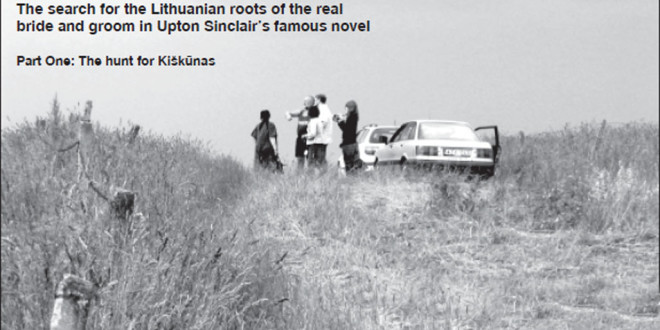by Randy Richards
Untangling angling anglingThe Jungle
ONE OF THE MAIN PURPOSES of our trip to Lithuania was to continue the research begun by Dr. Giedrius Subačius on the people and places behind the writing of Upton Sinclair’s The Jungle. Giedrius’ book, Upton Sinclair: The Lithuanian Jungle, has triggered an effort by him and me and Risé Sanders, a Chicago filmmaker, to make a documentary about the story behind the story of The Jungle. This trip was to extend the search for the real people and information beyond the Chicago connections.
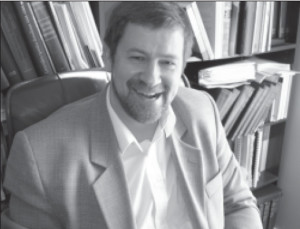
I am the Dr. Watson to Subačius’s Sherlock Holmes in these matters. Sometimes bumbling, I ask many obvious questions, once in awhile I toss up a perceptive question. I do a little research – I managed to find a historic photograph of one of the locations in the Back of the Yards we were searching for – and I provide lots of enthusiastic support. But Subačius is The Man in these matters. He is Holmes sans calabash pipe and deerstalker cap, although he does sport a jaunty goatee.
He has discovered through remarkable deductive work and sheer dogged persistence, compiling an impressive collection of circumstantial evidence, the names of the real wedding couple who were the inspiration for the opening chapter of the novel. Until his research no one knew who they were. We are now virtually certain they are Vladislovas (Walter) Kiškū- nas and Karolina Kazlauskaitė (Kazlauskas).
Through their obituaries in Lithuanian newspapers in Chicago, he had also traced back the separate villages from which the bride and groom emigrated out of Lithuania. Up to now, the research has been done primarily through document sources: birth certificates, death certificates, census records, social security records, plat maps, etc. Giedrius has constructed an elaborate and in-depth family tree of the Adomas Kiškūnas family. Adomas and his wife had three sons: Adomas, Jurgis and Juozapas. Walter is the son of Juozapas. Each of the sons had their own families. He had charted them as well. We know more about their family connections than any of the Kiškū- nas family does.
Now it had come down to locating and meeting people who were related to Walter Kiškūnas and Karolina Kazlauskaitė, the real life groom and bride of The Jungle. Giedrius had identified the Panevėžys region generally and the Stultiškiai village specifically as the focus of our search for links related to Walter. Two weeks before I arrived in Vilnius, Giedrius had made some initial contacts of likely relatives and locals who had information we were seeking. He found them during his first trip to Stultiškiai. Following that first trip, he started working in archives, and from what he learned was able to definitively conclude that Vladislovas’ (Walter’s) grandfather was Adomas.
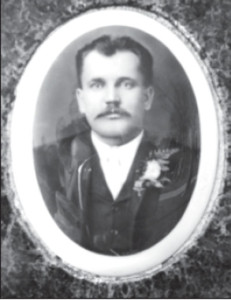
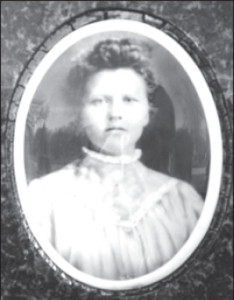
This return trip for him and the first for me was the payoff for two years of hard work and research, running down dozens of dead ends and sifting through thousands of pieces of information for connection and relevance. We had high hopes of interviewing the living descendants of Adomas and hence relatives of Walter. We also intended to search for graves, old photographs, and other documentation of the family.
Giedrius picked up my wife, Dolores, and I at our flat in Vilnius at eight in the morning. Neringa, his wife, was away in Kaunas teaching so she could not join us but his sixteen year old daughter Daukantė did. Loaded up with snacks and water, we headed to the Panevėžys region about two hours north of Vilnius.
Panevėžys is the fifth largest city in Lithuania, about 125,000 inhabitants. Located in flatlands and forests, it was known in the past for its theatre troupe, beer making, and a school founded by the Russians during the first occupation in the 19th Century to teach Lithuanian to Russian teachers for Russian dominated Lithuanian schools. It was connected to an Orthodox church and was known as the Seminary. One of the teachers there was a man by the name of Liackij. He is the subject of Giedrius’ new book.
It was a pleasant drive and along the road we saw new commercial development and new housing projects being built. The countryside was rolling hills and pastures interspersed with forests and small towns. Farms were small with few cows and farm plots more like large gardens than true farms. Here and there small stands of rye, wheat and oats were planted.
On the outskirts of Panevėžys, we spotted a large field with red poppies in it. Daukantė and Dolores wanted to stop for pictures and to pick some of the flowers and so we pulled over for a photo-op and bouquets.
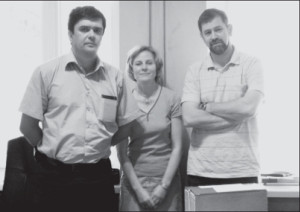
Even as we are working on this project, like all creative people, Giedrius has another project he has started as he is finishing one. He laid out the day so that the morning would be spent on his research at the museum in Panevėžys on Professor Liackij, and the afternoon with the Kiškū- nas clan research.
We began our research at the Panevėžys Museum in the former KGB headquarters. We were at the museum in search of old photos of the time, buildings, and people from the late 19th Century.
The staff there was exceptionally helpful and friendly. We spent the morning looking through old photographs from the region in search of artifacts for Giedrius’s Liackij project. Liackij is a kind of anti-heroic figure in Lithuanian history. A successful Russian engineer, who later in life found his way to Lithuania, and was pressed into service as a teacher of Lithuanian to Russian teachers who needed to know just enough Lithuanian to communicate with their students while they taught them Russian. Unfortunately, he, himself, did not know Lithuanian very well at all. As part of the Russian imperial designs he used the Cyrillic alphabet not the Latin alphabet, and set out to “prove” that Lithuanian had been derived from Russian. Ultimately, it all came undone and he was publicly discredited and eventually sacked. Since the school he taught at was in Panevėžys, we went to the museum to look for archival photos of the city in hopes of finding pictures of the school and the town during that period.
Giedrius had called ahead and had an appointment with Arūnas Astramskas, the museum director. The museum is located in the middle of the downtown in a building that was originally a church, then it housed the KGB headquarters, and now it is the local museum.
Astramskas showed us around the exceedingly modest museum. It has just what you would expect for a local history museum. Go to any of them in any town, in Lithuania or the United States, and they are almost identical except for the particularity of detail: odds and ends artifacts scrounged from local residents, tools, household items, a few pieces of period furniture, pieces of clothing, and old photographs. Often each has its own specialty. This one has a large collection of butterflies and insects gathered and mounted by one of the local high school biology teachers. Director Astramskas was quite proud of this collection and told us that it was the largest collection on display in Europe and had the largest butterfly (from Brazil) on display.
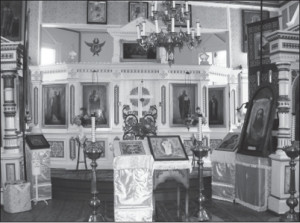
But the museum had another specialty, or better, specialist: Zita Pikelytė. She was an expert on local past photographers and historical photographs. She oversaw a collection of old photos from the region. This is why we came here. Giedrius, Dolores and I spent a couple of hours looking through hundreds of old photos for Liackij connected material. We found about 20 photos Giedrius could use.
Then the director took us to lunch and a brief walking tour of the older part of town. We stopped at the library and were joined by one of the librarians, Loreta Dundulienė, who is knowledgeable about local history. We then headed to the old Russian Cemetery to find the graves of Liackij and any other people connected to him. Giedrius had previously visited Panevėžys and spoke by phone to Valentina Vatutina, the unofficial historian and cultural liaison for the Russian minority. She met us at the graveyard which was located within walking distance of the museum.
The graveyard is more like a small park that residents pass through from one section of town to the other. Part of the attraction of the graveyard/park is the beautifully maintained Russian Orthodox church, the Church of the Resurrection. Valentina gave us a tour of the church before she took us into the graveyard to look for the graves.
The inside of the small church was even more beautiful than the outside and spoke to the loving care that the 300 member congregation lavished on the center of their worship services.
After the tour of the inside of the church, we entered the graveyard and began searching for the graves of Liackij and others. While the graveyard was not large, it was in a state of slow deterioration and it was difficult at times to identify the names on the graves. The grave of Liackij, however, was not hard to find this trip, but when Giedrius visited before he could not find the grave because it had recently collapsed. He learned about this shortly after his visit from reading an interview with Vatutina in the newspaper. During our visit we witnessed the restoration underway.
Valentina was a real treasure. She had a strong grasp of local history and was especially knowledgeable about the graveyard and many of the prominent people buried there. She helped us find those connected to Liackij.
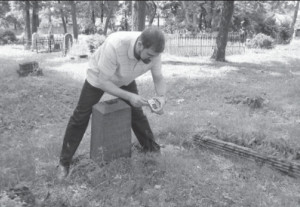
We found Liackij’s grave and other graves of importance to Giedrius work. My impression of the old small graveyard is that vandalism and a dwindling Russian population will slowly erase this place from memory.
After we finished at the graveyard, we left Panevėžys heading south toward Šilagalys to find the home of Julija Kiškūnaitė-Mackevičienė. Giedrius had gotten her name as a Kiš- kūnas relative from a contact he had in Vilnius. He had called her and she had agreed to meet us.
We knew how to get to the village, but once there we were not sure of the address because Julija told us the address but did not give directions, adding only, “Oh, it is easy to find, just look for the red roof.” Unfortunately once we arrived, the village was a bit larger and more spread out than we expected. Plus, red roofs abounded. After asking two locals for information, neither of whom knew exactly the street location, we stumbled upon the house. She was right about the red roof.
We met with Julija and her daughter, Dalia Mackevičiūtė. Giedrius explained again what we were doing and that we were trying to find and photograph the village Stultiškiai of Adomas Kiškūnas. We also wanted to understand Julija’s relationship to Adomas and then, of course, to Walter. After some confusing conversation, we showed her the family tree that Giedrius had constructed for the Kiškūnas family. Julija, or more properly Julijona, is the daughter of Antanas Kiškūnas, who was the son of Kazimieras Kiškūnas, who was the son of Jurgis Kiškūnas, the brother of Walter’s father Juozapas! It took awhile to explain all of this to her as well.
Julija had a few old photos of family (including one of a wedding couple in Chicago from 1904, but she didn’t know who they were) and places that we thought might be useful, so Giedrius made photos of them himself. Julija then agreed to accompany us to the Stultiškiai village. First we visited the home of Karolis Dailydėnas in Stultiškiai. He is a local resident whom Giedrius came across who is deeply interested in the history of the area. He has been a great help to us in looking through local archives, old maps, letters, and other artifacts that may bear some information about our search.
He lives in Stultiškiai himself. He has a strong opinion about where the family farmstead was. Julija might be able to confirm if this is where she grew up. So we drove to Stultiškiai to Karolis Dailydėnas’s house near Upytė a few kilometers away.
It turns out that when we arrived, Julija and Karolis recognized each other from years ago.
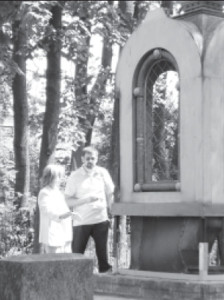
Karolis Dailydėnas and Danutė, his wife, showed us great hospitality by welcoming us into their beautifully restored country cottage and serving us some refreshments. After we talked for awhile and discussed the Kiškū- nas family, Karolis lead us out to where he thought the farmstead was. It was less than two kilometers from his house down a dirt path through some fields behind Karolis’ house.
The place of the old village and farmstead is now nothing but grain fields and pasture land. The Soviets tore down the village in the ‘50s as part of their “amelioration” process where small villages were destroyed and the inhabitants forcibly removed to nearby towns or sent to slave labor camps in Siberia. They turned the land over to collective operations. This happened throughout Lithuania so that the only traces that remain of these villages are on old maps and in the memories of elderly Lithuanians like Julija. We were lucky to find this place and without the help of Karolis and Julija it would have been impossible.
Later additional archival research by Giedrius clearly establishes that the farmstead of Julija’s youth was built in the fields just around 1920 or even later. It means that Vladislovas was born somewhere in the center of the village, somewhere on the street where Karolis Dailydėnas lives.
Julia confirmed that this was the site of her family’s land and farms (from 1920 on). She said she could locate them because of the presence of trees and other topographical features.
After visiting the farmstead, we visited the family graves in the cemetery next to St. Karolio Baromejaus Church at Upytė. It was one of the best tended graveyards we have ever visited. The families in town care fully planted, watered and weeded the graves showing their respect for their ancestors.
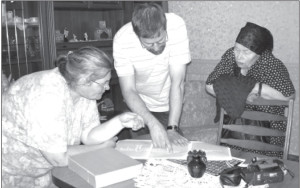
Julija took us to the graves of her parents and grandfather on her father’s side.
We were unable to locate the graves of any other close relatives further back in the line of succession, nor could we find the grave of Juozapas Kiškūnas, Walter’s father. There were other Kiškūnas graves in the cemetery but these were more distant relatives of Walter. While we were looking at graves and talking with Julija, her half-sister Gražina who lives near the cemetery saw us with her sister and came over to check out what we were doing.
She posed for some pictures with us and invited us to have some refreshments at her house. Unfortunately we were out of time for the day, but we promised to see her when we returned again.
We drove Julija back home to Šilagalys. We expressed our gratitude for all of her help and promised to send her pictures of the day. She was obviously pleased with our attention and interest in her family.
After we dropped her off we made one more trip back to Stultiškiai to take some pictures of a windmill on the edge of town owned at one time by Michael Kiškūnas – a relative. The mill is now an occasional museum with no regular hours, “call for a showing, please.” It is about one kilometer away from the farmstead of Julia’s parents.
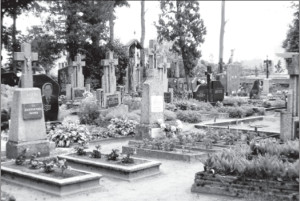
Daukantė said good bye to her new friends, the Cows of the Mill and we returned to Vilnius excited about discovering the Kiškūnas farmstead and meeting Julija and finding the graves of some of the Kiškūnas family. We were fortunate to have the assistance of Karolis and Julija.——–
 DRAUGAS NEWS Lithuanian World Wide News in English
DRAUGAS NEWS Lithuanian World Wide News in English
